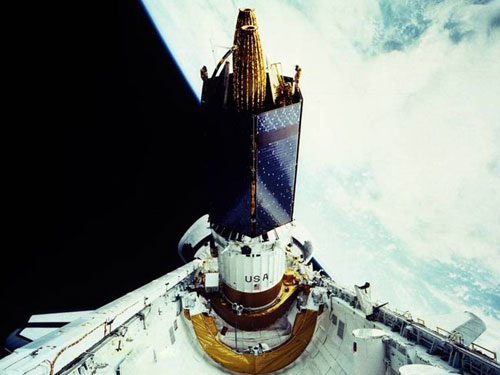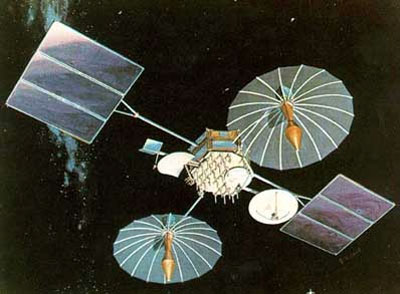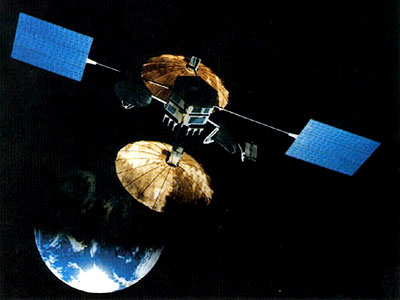|
|

|
|
Author
|
Topic: Tracking and Data Relay Satellites (TDRS)
|
Robert Pearlman
Editor Posts: 42988
From: Houston, TX
Registered: Nov 1999
|
 posted 05-27-2008 10:12 AM
posted 05-27-2008 10:12 AM
   
NASA feature TDRS: 25 Years of Connecting Space To Earth Above: In April 1983, the first Tracking and Data Relay Satellite, TDRS-1, was launched from space shuttle Challenger's payload bay on mission STS-6. Twenty-five years ago, NASA inaugurated a new era in spacecraft communications with the launch of the first Tracking and Data Relay Satellite, or TDRS. This space-based system ultimately replaced an extensive network of ground tracking stations deployed for the Apollo missions and significantly increased the time available to mission operators to contact their flight vehicles. Perched 22,300 miles above the equator, the satellite rotated Earth at the same speed and direction that the Earth turns. Relative to a point on Earth, TDRS appeared to remain stationary. From that geosynchronous orbit, it beamed communications from Earth to other orbiting spacecraft and back, establishing itself as a reliable resource for NASA's space shuttle and other customers. TDRS-1 provided a link for the first wireless phone call between the North Pole and the South Pole, and the first live webcast from the North Pole. It also was the first satellite to connect to the Internet. Soon, more TDRS satellites joined the Tracking and Data Relay Satellite System, forming a constellation of nine NASA satellites that today provides nearly continuous tracking and high-bandwidth communications with scores of Earth orbiting spacecraft, launch vehicles, long duration balloons, and a research station in Antarctica. "When many people look at the TV and see beautiful pictures coming from the shuttle or space station, they take communications for granted," said Badri Younes, NASA deputy associate administrator for Space Communications and Navigation. "They don't know the capabilities that NASA leverages in getting this data down to the ground." Over the last 25 years, the TDRSS network has brought stunning images from the Hubble Space Telescope to Earth. It has delivered pictures, television, voice and data from more than 100 space shuttle missions and the International Space Station. The TDRSS network has delivered large volumes of Earth observation data in support of Mission to Planet Earth and investigations into global climate change. Other TDRSS users have included the Automated Transfer Vehicle, Solar Mesosphere Explorer, Solar Maximum Mission, Compton Gamma Ray Observatory, Terra, Landsat, SWIFT, Earth Radiation Budget Satellite, Cosmic Background Explorer, Extreme Ultraviolet Explorer, Aqua, and Aura. The TDRS system has evolved over the last 25 years to meet expanding user requirements and provide new services. Meanwhile, the very first TDRS satellite that was deployed by space shuttle Challenger in April 1983 is still on duty today, returning data from the National Science Foundation activities at the Amundsen-Scott South Pole Station in Antarctica. |
jasonelam
Member Posts: 691
From: Monticello, KY USA
Registered: Mar 2007
|
 posted 05-31-2008 11:07 PM
posted 05-31-2008 11:07 PM
   
Are there any plans to launch any other TDRS satellites to continue the system if or when one of the older ones should fail? Let us remember that the first TDRS satellite has been in orbit over 25 years. |
cspg
Member Posts: 6210
From: Geneva, Switzerland
Registered: May 2006
|
 posted 06-01-2008 12:04 AM
posted 06-01-2008 12:04 AM
   
The one pictured is an earlier model (TDRS A-G). Next generation (H,I,J) were launched between 2000 and 2002.TDRS K and L contract was awarded to Boeing (same for H,I,J) in December 07. |
Greggy_D
Member Posts: 977
From: Michigan
Registered: Jul 2006
|
 posted 06-01-2008 01:15 AM
posted 06-01-2008 01:15 AM
   
Which shuttle flight was the first to use TDRS's capabilities? STS-7? |
cspg
Member Posts: 6210
From: Geneva, Switzerland
Registered: May 2006
|
 posted 06-01-2008 04:18 AM
posted 06-01-2008 04:18 AM
   
Doubtful since the first TDRS was launched on STS-6 (April 83) and the IUS misfired requiring the satellite's own propulsion to reach geostationary orbit. If you add check out times and the fact that STS-7 launched in June (83)... but I may be wrong. |
cspg
Member Posts: 6210
From: Geneva, Switzerland
Registered: May 2006
|
 posted 06-01-2008 09:38 AM
posted 06-01-2008 09:38 AM
   
quote:
Originally posted by Greggy_D:
Which shuttle flight was the first to use TDRS's capabilities?
First tests took place during STS-8: Testing was conducted between the Tracking and Data Relay Satellite-I (TDRS-1). |
jasonelam
Member Posts: 691
From: Monticello, KY USA
Registered: Mar 2007
|
 posted 06-01-2008 09:54 PM
posted 06-01-2008 09:54 PM
   
As a safeguard against TDRS service failure, the contract specifies a payback schedule to reimburse NASA for any failures incurred during the first 8 years of the satellites' 11-year operational lifetimes. -- Boeing website WOW! That's some kind of warranty! I wish cars had that kind of contract.  |
cspg
Member Posts: 6210
From: Geneva, Switzerland
Registered: May 2006
|
 posted 06-01-2008 11:21 PM
posted 06-01-2008 11:21 PM
   
I wonder if that guarantee came from the fact that early Boeing 601 satellites ran into operational problems once on orbit...
|
Robert Pearlman
Editor Posts: 42988
From: Houston, TX
Registered: Nov 1999
|
 posted 10-14-2009 04:05 PM
posted 10-14-2009 04:05 PM
   
NASA release NASA Retires Pioneering Tracking and Data Relay SatelliteAfter a rocky start and then a stellar 26-year performance, NASA's Tracking and Data Relay Satellite-1 (TDRS-1) is scheduled for decommissioning on October 28. Communications equipment that links TDRS-1 to the ground has failed and without this capability it can no longer relay science data and spacecraft telemetry to ground stations located at the White Sands Complex in Las Cruces, N.M., and on Guam. "Our immediate plans are to develop a strategy to shut down critical payload systems aboard the satellite," said Space Network Project Manager Roger Flaherty at NASA's Goddard Space Flight Center. "Then the team will execute maneuvers to raise TDRS-1's orbit, thus eliminating potential collision dangers with other communications satellites in geosynchronous orbit."  TDRS-1 had many firsts. Its position over the Indian Ocean successfully eliminated the "Zone of Exclusion" in an area where communications with spacecraft were previously impossible, thus providing true global coverage for all TDRS System customers. In 1998, TDRS-1 garnished world-wide publicity when it provided the first medical teleconferencing link, complete with voice, video and imaging data from the South Pole. It was used again in July 2002 to provide continuous, dropout-free data during a two-hour telemedicine event involving a physician at the Amundsen-Scott South Pole Station and physicians at the Massachusetts General Hospital in Boston. "Amazing results from a satellite that almost didn't make it to orbit," said Flaherty. TDRS-1's upper stage failed upon deployment from the space shuttle in April 1983. Engineers at Goddard came to its rescue using the tiny, one-pound thrusters onboard the spacecraft. Over the course of several months they fired the thrusters to nudge TDRS-1 into its geosynchronous Earth orbit. NASA has used the satellite in ways never expected because its orbit has been inclining almost one degree per year since deployment. Goddard's Space Network Project provides overall management and direction of the operation and maintenance of the TDRS system, which consists of the on-orbit TDRS, the ground terminal on Guam and the ground complex at White Sands, N.M. |
Robert Pearlman
Editor Posts: 42988
From: Houston, TX
Registered: Nov 1999
|
 posted 06-25-2010 04:01 PM
posted 06-25-2010 04:01 PM
   
NASA release NASA Retires First Data Relay Satellite After Stellar CareerAfter a long and successful career providing communications support, NASA's groundbreaking Tracking and Data Relay Satellite (TDRS) 1 is retiring. On Sunday, June 27, NASA will shut down the satellite that launched into orbit during space shuttle Challenger's maiden voyage (STS-6) in April 1983. From 1983 to 1998, TDRS-1 provided NASA with the ability to communicate with other satellites in orbit. NASA reassigned TDRS-1 in 1998 to support the National Science Foundation's (NSF) U.S. Antarctic Program and others on scientific, educational and operational endeavors.  TDRS-1 worked with eight additional satellites to relay data and communications from more than 15 customers, including the NSF, the Hubble Space Telescope, the shuttle and the International Space Station. The TDRS system provides the capability not only to send commands and receive data, but also to navigate and talk with crews in orbit. "TDRS-1 paved the way for this incredible space communications system," said Bill Gerstenmaier, associate administrator for NASA's Space Operations Mission Directorate. "The remaining TDRS satellites, and the new satellites that will be online within three years, will carry on these critical capabilities for many NASA missions, including science and human spaceflight." TDRS-1 was the first satellite used to support launches from NASA's Kennedy Space Center in Florida in the early 1990s, returning real-time telemetry. It eliminated a dead zone over the Indian Ocean where there previously was no communication, providing full coverage for the space shuttle and low-Earth orbiting satellites. TDRS-1 proved helpful during a 1999 medical emergency at the NSF's Antarctic Amundsen-Scott South Pole Station. The satellite's high-speed Internet connectivity allowed personnel to conduct telemedicine conferences. Doctors in the United States aided Dr. Jerri Nelson, who had breast cancer, in performing a self-biopsy and administering chemotherapy. Later, in 2002, doctors used TDRS-1 to perform another telemedicine conference with the station to assist in knee surgery for a meteorologist. Because of its orbit, the satellite was able to link the North and South Poles and relayed the first pole-to-pole phone call. TDRS-1 also transmitted the first internet connection and live webcast from the North Pole and supported the first global television event from the South Pole Station, a worldwide tv broadcast to commemorate the beginning of the year 2000. TDRS-1 was instrumental in supporting innovative astronomy and astrophysics research programs at the South Pole Station, including the one-of-a-kind IceCube Neutrino Observatory and the South Pole Radio Telescope. The satellite transmitted gigabytes of science research data to university researchers worldwide on a daily basis. The first six TDRS satellites were built by TRW Inc. (now Northrop Grumman Corp.). Boeing Space and Intelligence Systems also built three TDRS satellites. NASA plans to launch two additional satellites into the Tracking and Data Relay Satellite System by 2013. On June 13, 2010, the satellite arrived at its final destination, approximately 22,500 miles above the Earth. After the orbit is stabilized and the remaining fuel removed, NASA will shut down the satellite on Sunday, June 27. | |
Contact Us | The Source for Space History & Artifacts
Copyright 2020 collectSPACE.com All rights reserved.

Ultimate Bulletin Board 5.47a
|
|

|
 advertisement advertisement

|















